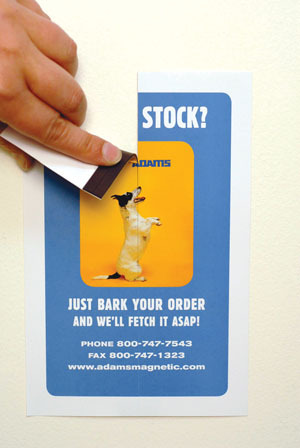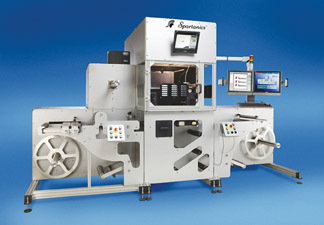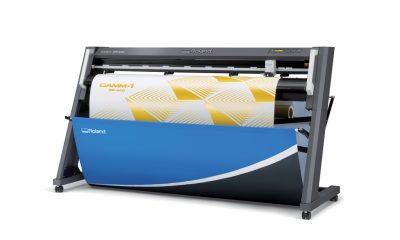Graphics Printing
Published
15 years agoon

Print providers serving clients with temporary graphics needs and shops who produce elements for P-O-P know that the only thing constant in this business is change.
And while many in the industry—suppliers and clients alike—don’t immediately think of using magnetic systems for wide-format applications, when it comes to producing jaw-dropping graphics with quick-changing ability, one of the oldest technologies for making one thing cling to another is exhibiting some attractive properties.
What follows are just a few reasons why print providers should take a closer look at the possibilities inherent in magnetic media systems.
Attractive offerings
Magnetic display systems of all kinds are available from more than a few providers across the marketplace. Standard offerings include “sign blanks,” for easy printing of those familiar vehicle door ads; adhesive magnet strips that make virtually any graphic magnetic; and, perhaps most importantly for our market, flexible printable magnet, also known as magnetic media. And even if a metal wall isn’t available, a variety of companies have developed rolled material, which will stick to a wall on one side and accept flexible printable magnet on the other.
“Magnets often enhance design, offer limitless potential for customization, and can be quickly, neatly updated with minimal tools and no training,” says Heather West for Adams Magnetics, which produces flexible magnets. In recent years, people have also found that magnets contribute to green and lean initiatives because much of the material used to make magnets is repurposed material and they are recyclable and reusable.
As you might guess, the industry’s suppliers make a wide array of magnetic media available. Here’s a sampling (for a sourcelist of these suppliers, as well as others, see page 22):
For solvent machines, MagX America offers SolvMag, available in a 40-inch width and 20- or 30-mil thicknesses plus laminate. SolvMag includes a direct digital print laminate in white luster for photo-quality prints and a UV-cured back coating process to protect against sticking, staining, and blocking, reports the company. MagX also provides photo-quality Inkjet Papermag, specifically for interior applications; it’s a 20-mil plus laminate material that comes in a 24 3/8-inch width.
Adams Magnetics sells MeterMag, which is a meter wide, is available in 20- or 30-mil thicknesses, and can be specified with an indoor adhesive surface, a white matte vinyl surface, or a plain surface, for use with solvent machines. Adams also offers Magsteel, which combines a printable surface with lightweight metal to create a printable, metal backing that will accept magnetic media; it’s supplied with a white, printable surface on both sides; or with adhesive on one side. In addition, the company’s Magbond is a rubber-based ferrous, or metal sheet to which magnets will stick, supplied in rolls and available with adhesive and white coatings.
Magnum Magnetics offers DigiMag Vinyl, which is 24 3/8-inches wide and is available in thicknesses ranging from 8 to 60 mil. It posts profiles on its website for a number of wide-format solvent printers. Magnum also manufactures DigiMag Paper gloss and matte, in thicknesses ranging from 8 to 30 mil. And the company offers MessageMag, a thin, lightweight and customizable flexible magnetic sheeting in 24 3/8-inch-wide rolls (or cut pieces) in thicknesses of 11 and 11.8 mil for the Xerox iGen and HP Indigo presses.
Master Magnetics offers PrintMagnet Vinyl in 24 inches (and wider widths upon request) and in 12- to 30-mil thicknesses with white vinyl on one side for solvent and eco-solvent machines. Also available is FlexIron, a 24.4-inch-wide x 25-mil thick printable magnetic-receptive roll, which works as a backing for printable magnet as well. And the company offers 24- and 42-inch-wide PrintMagnet in 12-mil thicknesses and up, with two different laminates: matte white paper or high-gloss photo-quality paper.
Drytac’s DisplayMag is another example of a printable magnet available in a 39.5-inch width; however, this product has a white PVC face that can be printed on with screen, solvent, or UV printers and features a pressure-sensitive adhesive back. DisplayMag permits the use of magnetic-receptive media or Drytac’s FerroJet by serving as a magnetic backing for other media, but it can also be printed on.
Twists on traditional
Despite the fact that flexible magnet offerings span from 12- to almost 40-inch-wide rolls and are available in an array of colors, cuts, and thicknesses, some shops have discovered the appeal and efficiency of the traditional magnet system in reverse—that is, with a magnet sheet backing adhered, or permanently installed, on a wall and a thin paper substrate coated with metal (that can be printed on using virtually any machine) applied to the magnetic backing.
Case in point: Graphic Systems in Minneapolis, which has found success with a “magnetic-receptive system” from Xcel Products.
“We actually came upon it at the SGIA show in 2007,” says Marty Kauls, Graphic Systems’ marketing manager. “We thought it was a cool product, and when we returned home, Wilson’s approached us.”
The major US leather retailer, which was only a prospective client at the time, explained that it wanted to be able to change out its 8 x 10-foot murals three to four times a year. It was then that Graphic Systems performed an in-house demonstration of the magnetic-receptive system they’d previously seen at SGIA as well as a pressure-sensitive vinyl system. It didn’t take much to sell Wilson’s on the magnetic-receptive media: Using the product made much more sense for Wilson’s Leather because the printed media is easily rolled up, placed in tubes and shipped for less than images printed or mounted on rigid material, Kauls explains.
Shortly after the in-house tests, Kauls and crew output the graphics for the first 8 x 10-foot mural for use in Wilson’s concept store in Minneapolis, Minnesota, onto Xcel’s VM Polyeight 8-mil Satin Polyester. Three 33-inch panels were printed using Graphic Systems’ Durst Rho 351R with Durst UV inks, then cut with a Zund cutter. The mural was then applied to the magnetic backing, which had already been adhered to the store wall.
“Getting the proper installation of the magnet to the wall is crucial,” says Kauls. Magnetic backing, with which the changing printed graphics correspond, does require professional installation and a strong adhesive custom for every wall, he points out.
In fact, the only trouble Kauls and crew had in the whole execution of the job was using the correct adhesive on the magnetic backing. Future image changes can be handled by store employees who simply line up the edge of the magnetic-receptive image to the backing and unroll it.
Since Graphic Systems’ work with Wilson’s, the shop has had a swarm of retailers clamoring for the magnetic-receptive system. “For the retailer that’s using large-format murals at its store locations on a regular basis, this is the material for them,” Kauls says. Xcel Products’ Visual Magnetics line comprises a group of substrates up to 60-inches wide from satin polyester to polypropylene in five- and eight-mil thicknesses, which can be used in almost any aqueous, UV, or solvent machine.
Other manufacturers also are offering print providers the opportunity to use magnetic technology without actually requiring direct printing on magnet. Available alternatives include Drytac’s FerroJet, which similarly has a very thin ferrous, or metal coating on the back of a traditional inkjet paper and allows the product to match-up perfectly to a magnetic backing. FerroJet is available in 9 mil for aqueous and eco-solvent machines and in 5 mil for UV flatbed printing. An installer must first apply a 12- to 24-mil magnetic sheeting on a wall using permanent pressure-sensitive adhesive, with the magnetic side facing out, away from the wall. Graphics can be printed on FerroJet, and when it is held close to the magnetic sheeting, it will literally apply itself.
And as an alternative to magnetic-adhered backing systems, Drytac also produces FerroCoat: a paint that consists of ferrous materials. After three to four applications of FerroCoat on a wall, clients can apply printed flexible magnet to the surface without adhesive. Because ferrous elements are in the paint, the magnet will attach naturally.
Those print providers seeking “green-ness” will be happy to know that the product can be disposed of in a landfill. “Polyester has a very high recyclable content,” notes Marc Oosterhuis, president of Drytac. “Ferrous material is a very thin metal coating and is not hazardous. It will oxidize and disappear.”
A magnetic future
Whether print providers are drawn to flexible printable magnets, magnetic-receptive systems, or something in-between, the magnetic solutions for wide format are constantly improving.
“Size, speed, and customization are the most notable innovations for flexible magnetic materials,” says Heather West of Adams Magnetics. “To keep up with demand, high-volume customers seek bigger and bigger rolls. To keep costs down, the push is toward thinner and thinner material. Twenty years ago, .030-inch thicknesses were standard. Today, some materials are less than .010-inches thick. Correspondingly, the laminates are thinner, too. Some thin sheet materials can be treated almost like paper with binding and stitching. There are more choices than ever for flexible magnetic media.”
The future for magnetic products is bright, says Oosterhuis: “I think there’s a lot of growth at the moment. There’s no question in my mind that it’s a growing segment. It will depend a little bit on whether people continue to look at new things. People are not as open to new things because of the recession. We need people to fully understand what they can do with the products. If they get one good experience with the product, then it will really take off.”
What Does This Mean for My Machine?
Printable magnet has been around for quite a while, but print providers are known to keep away from magnetic media for fear of the unknown. Will magnet negatively affect my machine? Will printheads be damaged? What kinds of problems will arise during and after printing? Is the risk worth taking? No one answer satisfies those concerns because problems and solutions honestly depend on the machine in question.
While it’s true that print providers who are looking to expand into magnetic media may need not purchase any special equipment, a couple of things should be considered:
• Technically, wide-format printers and magnets have just one issue: Magnets will naturally attach to anything ferrous or containing iron, like platens. Magnet manufacturer MagX suggests covering those platens with chip board made of non-ferrous material in order to break the bond.
• It's also important to know that excessive heat will distort thin flexible magnet below 30-mil thicknesses. It may be a good idea to turn down the heaters on digital presses when printing on flexible magnet, and it might also be a good idea to ensure that pinch or guide rollers are down and functioning.
To address these concerns, some manufacturers have gone to great lengths to ensure ease for machines during the magnet printing process. Companies such as Magnum Magnetics and Drytac sell unmagnetized sheeting and handheld magnetizers for print providers or installers to use after graphics have been printed.
Ashley Ferguson is the former assistant editor of The Big Picture magazine.
Editor’s note: This article was updated from a previous piece that appeared in the March 2009 edition of The Big Picture.

Subscribe

Magazine
Get the most important news
and business ideas from Screenprinting Magazine.
Most Popular
-

 Art, Ad, or Alchemy1 month ago
Art, Ad, or Alchemy1 month agoF&I Printing Is Everywhere!
-

 Case Studies1 month ago
Case Studies1 month agoHigh-Density Inks Help Specialty Printing Take Center Stage
-

 Andy MacDougall1 month ago
Andy MacDougall1 month agoFunctional and Industrial Printing is EVERYWHERE!
-

 Columns2 weeks ago
Columns2 weeks ago8 Marketing Mistakes Not to Make When Promoting Your Screen Printing Services Online
-

 Editor's Note2 weeks ago
Editor's Note2 weeks agoLivin’ the High Life
-

 Thomas Trimingham2 months ago
Thomas Trimingham2 months ago“Magic” Marketing for Screen Printing Shops
-

 Marshall Atkinson2 weeks ago
Marshall Atkinson2 weeks agoHow to Create a Winning Culture in Your Screen-Printing Business
-

 News & Trends1 month ago
News & Trends1 month agoWhat Are ZALPHAS and How Can You Serve Them in Your Print Business?






